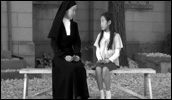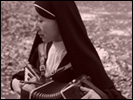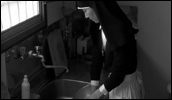Autumn Adagio
- Year
- 2009
- Original title
- Fuwaku no Adagio
- Japanese title
- 不惑のアダージョ
- Director
- Cast
- Running time
- 70 minutes
- Published
- 13 July 2009



by Tom Mes
Director Tsuki Inoue's previous film The Woman Who Is Beating the Earth dealt with a butcher's shop assistant who suffers physical abuse at the hands of her boyfriend. Nevertheless, she can't stop loving him. Even after finally striking back. The film was a 20-minute wallop of condensed intensity.
Inoue's new film Autumn Adagio deals with a 40-year-old Catholic nun who has spent most of her life suppressing her physicality and femininity. When three very different men cross her path and the shadow of menopause looms, she begins to change. Yet, she can't shed the habit. Even after finally knowing physical love. The film is a 70-minute flow of languid restraint.
Sister Maria (Shibakusa) plays the organ in church. It seems to be her sole source of joy, but this is hard to tell. Introverted and solitary, she lives a life of monotony and routine. She is sickly and weak, just recovering from an illness that kept her bedridden for much of the summer. We see her removing the stamen from a bouquet of flowers near the altar, ostensibly to stop the spread of pollen, but the symbolism is hard to miss.
Her awakening comes when the autumn leaves start to fall. Three men enter Sister Maria's life. First, a geeky, vaguely repulsive middle-aged churchgoer asks her help in solving an "impossible love". She ends up literally pushing him away, but physical contact has been made. Next, she is asked to deliver the letters of an ailing old lady to her estranged son, who seems to have turned his back on anything but gardening. Her insistence gradually pierces his armor, but it also creates a mutual fascination between the Christ-like gardener and the repressed nun. Finally, asked to replace an absent pianist at a ballet school, Sister Maria is slowly enraptured by the sight, the body and the movements of its handsome instructor (real-life dancer Nishijima). At first, when he asks her to play with a bit more feeling, she stares back blankly. But the feeling soon emerges. The nun is a woman like any other, a mother's daughter, object of and subject to desire.
In keeping with its protagonist's personality, Autumn Adagio is an understated piece of work, shot predominantly in long takes from fixed camera positions. It's hard to imagine a greater stylistic contrast with Inoue's previous film, but in both cases the formal choices are dictated by the subject. The color scheme consists mostly of subdued greys and earth tones, with blasts of yellow and red provided by the visual pattern of the autumn leaves. The video format coupled with the restrained style tend toward rather too much austerity at times, especially in exterior scenes, and there are moments when one wonders whether the director isn't trying a bit too hard to avoid repeating herself (some of the ballet scenes could have done with livelier direction to match the physical performances of the dancers). However, the style also results in instances of great beauty, notably the repeated shots of Sister Maria's daily routine, whose deliberate compositions echo the paintings of Vermeer (that echoing Vermeer on DV is indeed possible was already demonstrated by another Japanese amateur videaste, Shingo Ohuchi, in his 2005 film Clear People / Hito wa Inai).
Made independently with the money Inoue received with her Grand Prize in Yubari the previous year, Autumn Adagio is further evidence of the scope of its director's talents. It also shows that these talents will never come to full fruition within the restrictions of amateur filmmaking. It is clear that Inoue is capable of making the best of very limited means, but working with a professional cast and a skilled producer will help elevate her to the next level. From there, there is no telling how far Tsuki Inoue might reach.